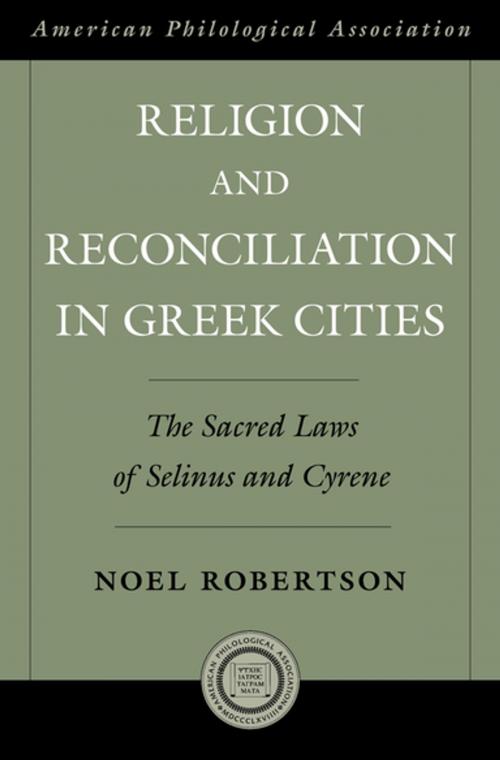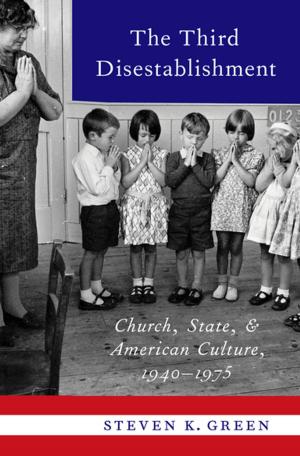Religion and Reconciliation in Greek Cities
The Sacred Laws of Selinus and Cyrene
Nonfiction, History, Ancient History, Greece, Religion & Spirituality| Author: | Noel Robertson | ISBN: | 9780190453138 |
| Publisher: | Oxford University Press | Publication: | December 1, 2009 |
| Imprint: | Oxford University Press | Language: | English |
| Author: | Noel Robertson |
| ISBN: | 9780190453138 |
| Publisher: | Oxford University Press |
| Publication: | December 1, 2009 |
| Imprint: | Oxford University Press |
| Language: | English |
Two Greek cities which in their time were leading states in the Mediterranean world, Selinus in Sicily and Cyrene in Libya, set up inscriptions of the kind called sacred laws, but regulating worship on a larger scale than elsewhere - Selinus in the mid fifth century B.C., Cyrene in the late fourth. In different ways, the content and the format of both inscriptions are so unusual that they have baffled understanding. At Selinus, a large lead tablet with two columns of writing upside down to each other is thought to be a remedy for homicide pollution arising from civil strife, but most of it remains obscure and intractable. The gods who are named and the ritual that is prescribed have been misinterpreted in the light of literary works that dwell on the sensational. Instead, they belong to agrarian religion and follow a regular sequence of devotions, the upside-down columns being reversed midway through the year with magical effect. Gods and ritual were selected because of their appeal to ordinary persons. Selinus was governed by a long enduring oligarchy which made an effort, appearing also in the economic details of sacrifice, to reconcile rich and poor. At Cyrene, a long series of rules were displayed on a marble block in the premier shrine of Apollo. They are extremely diverse - both costly and trivial, customary and novel - and eighty years of disputation have brought no agreement as to the individual meaning or general significance. In fact this mixture of things is carefully arranged to suit a variety of needs, of rich and poor, of citizens of long standing and of new-comers probably of Libyan origin. In one instance the same agrarian deities appear as at Selinus. It is the work once more of a moderate oligarchy, which on other evidence proved its worth during the turbulent events of this period. Religion and Reconciliation in Greek Cities provides a revised text and a secure meaning for both documents, and interprets the gods, the ritual, and the social background in the light of much comparative material from other Greek cities. Noel Robertson's approach rejects the usual assumptions based on moralizing literary works and in doing so restores to us an ancient nature religion which Greek communities adapted to their own practical purposes.
Two Greek cities which in their time were leading states in the Mediterranean world, Selinus in Sicily and Cyrene in Libya, set up inscriptions of the kind called sacred laws, but regulating worship on a larger scale than elsewhere - Selinus in the mid fifth century B.C., Cyrene in the late fourth. In different ways, the content and the format of both inscriptions are so unusual that they have baffled understanding. At Selinus, a large lead tablet with two columns of writing upside down to each other is thought to be a remedy for homicide pollution arising from civil strife, but most of it remains obscure and intractable. The gods who are named and the ritual that is prescribed have been misinterpreted in the light of literary works that dwell on the sensational. Instead, they belong to agrarian religion and follow a regular sequence of devotions, the upside-down columns being reversed midway through the year with magical effect. Gods and ritual were selected because of their appeal to ordinary persons. Selinus was governed by a long enduring oligarchy which made an effort, appearing also in the economic details of sacrifice, to reconcile rich and poor. At Cyrene, a long series of rules were displayed on a marble block in the premier shrine of Apollo. They are extremely diverse - both costly and trivial, customary and novel - and eighty years of disputation have brought no agreement as to the individual meaning or general significance. In fact this mixture of things is carefully arranged to suit a variety of needs, of rich and poor, of citizens of long standing and of new-comers probably of Libyan origin. In one instance the same agrarian deities appear as at Selinus. It is the work once more of a moderate oligarchy, which on other evidence proved its worth during the turbulent events of this period. Religion and Reconciliation in Greek Cities provides a revised text and a secure meaning for both documents, and interprets the gods, the ritual, and the social background in the light of much comparative material from other Greek cities. Noel Robertson's approach rejects the usual assumptions based on moralizing literary works and in doing so restores to us an ancient nature religion which Greek communities adapted to their own practical purposes.















